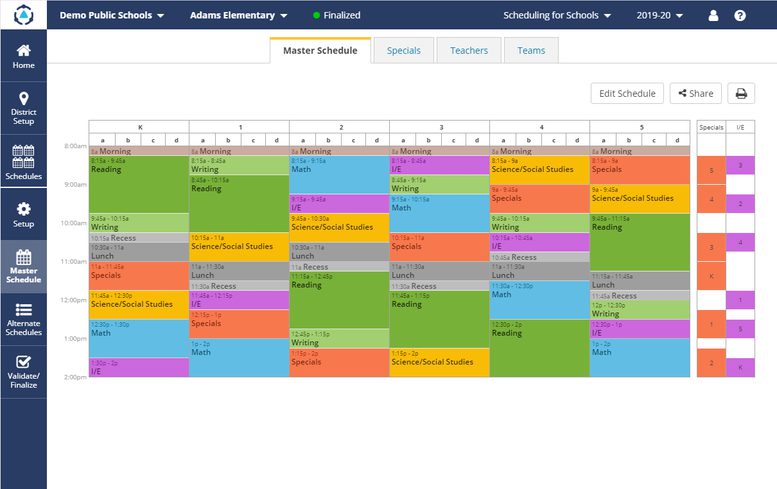This 12-part How to Build an Elementary School Schedule series shares expert step-by-step guidance and proven scheduling strategies to help you create better schedules this year.
Specials periods are often seen as one of the most complex and frustrating aspects of elementary scheduling. When it comes to facility space and staffing, specials are indeed one of the most highly constrained periods to schedule. Due to this, many schools default to historical scheduling practices year after year instead of pursuing more optimal approaches.
We recommend that you start building your schedule by placing your specials periods first. Here are a few ideas that may help you consider different approaches to scheduling specials.
- Create opportunities for grade-level collaboration time
- Prioritize morning core instruction for lower grades
- Think about transitions and teacher time
- Consider the best specials rotation for your school
- Address uneven numbers of sections per grade
- Design grade-level specials rotations thoughtfully
Schedule specials at the same time and for the same duration for all sections of a grade. Among other benefits, this grade-level scheduling tactic helps create daily common planning time opportunities for homeroom teachers.
Schedule specials for upper grades in the morning and for lower grades in the afternoon. This helps younger students engage in core instruction earlier in the day.
Consider transition time between specials periods so teachers have time to change materials between grades. Scheduling specials sequentially by grade can help reduce transition time by reducing dramatic shifts in required materials. Additionally, be sure to allow time for specials teachers' planning and lunches.
There are many different options for specials rotations (e.g. 3-day, 4-day, 6-day, etc.) beyond the traditional Monday through Friday rotation. Consider the option that best suits your facility and staffing constraints while providing equal access to specials for your students.
If you have a grade that has more sections than other grades, consider using a student regrouping strategy (i.e. regroup five sections into four sections) for specials. Regrouping can sometimes help you better manage facility and staffing constraints.
Establish grade-level specials rotations that only require one of each specialist per specials period. This is commonly done by aligning a school's maximum number of sections per grade to the number of specials offered unless regrouping is used.
Because specials are one of the most constrained periods to schedule, scheduling them first sets you up to successfully build your elementary school schedule. Consider the above approaches to identify the specials rotation that is optimal for your school.

About DMSchedules
Create Better School and Staff Schedules Now with DMGroup’s DMSchedules Scheduling Software
Learn moreElementary Scheduling Software

